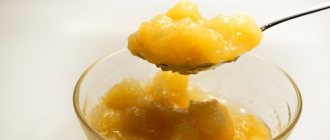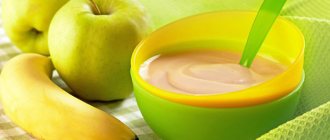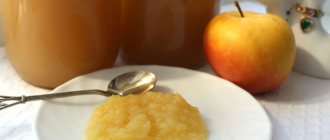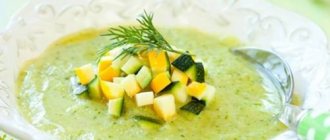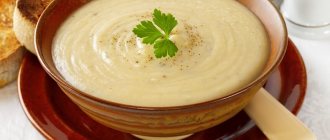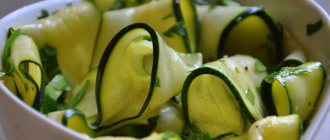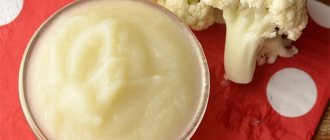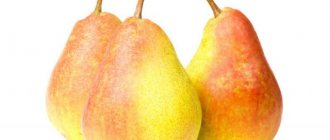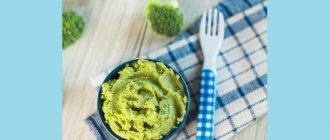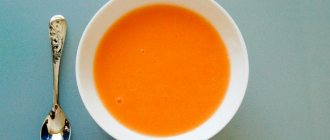Pumpkin puree - 6 recipes for making baby puree for babies
Many mothers prefer homemade pumpkin puree made on their own. In fact, this is the right decision, because this is the only way to know for sure what ingredients the baby’s complementary foods will consist of.
Classic pumpkin puree for babies
If you are asking questions about how to properly cook and how much to cook pumpkin for baby puree, then the information below will definitely be useful to you. Please try this recipe.
What you will need:
- pumpkin – 200 g;
- water – ½ cup.
Take a small pumpkin. It is advisable that it not be too old and tough. Give preference to young fruit.
- Separate 200 grams, peel and core. Then cut into small cubes, add half a glass of water and cook.
- Cooking lasts 15-20 minutes over low heat. When the vegetable becomes soft, it means it is ready and you can remove the pan from the stove.
- Grind the pumpkin into puree using a mixer or immersion blender and then you can feed it to your baby.
You can put a small sprig of greenery. The main thing is that it grinds completely.
Cooking with zucchini
Pumpkin puree for a baby with zucchini will be an excellent addition to complementary foods.
What you need for 100 grams of pumpkin:
- zucchini - 100 g;
- milk - half a glass;
- butter - a piece.
This pumpkin puree for babies is suitable for older babies - about 9 months.
- Tackle the vegetables first. Peel the zucchini and pumpkin, remove the core and cut into small pieces.
- Fill them in a saucepan with milk, if the child is not allergic to it, or with water and simmer for several minutes over low heat.
- After this, grind the vegetables until smooth, so that no fiber remains, using an immersion blender or mixer at high speed.
Pumpkin soup for little ones
The ingredients indicated in the recipe are for one serving of puree soup for a small child.
What you will need:
- pumpkin – 150 g;
- potatoes – 1 pc.;
- carrots – 1 pc.;
- onion – ½ pcs.;
- salt - a pinch;
- water – 2 glasses;
- spoon of olive oil.
Cooking algorithm:
- Pour water into a saucepan and bring it to a boil.
- Pumpkin and potatoes are cut into medium-sized cubes. They must first be peeled and washed thoroughly. Pay special attention to this moment, because you are preparing puree for a small child, which means that it must be clean, without unnecessary impurities.
- The carrots are grated on a fine grater, half of the onion is cut as finely as possible.
- Place all the ingredients in a saucepan and cook them in boiling water for half an hour over medium heat.
- After the vegetables are cooked, let them cool slightly and add the oil.
- Immediately puree them using an immersion blender or mixer. Add a pinch of salt, mix well and you can give the dish to your child.
A tasty and healthy dish with apples
Pumpkin combined with apple is a unique complex of vitamins and beneficial microelements for a growing body.
What you will need:
- pumpkin – 200 g;
- apple – 1 pc.
Let's prepare it like this:
- Rinse the pumpkin and apples thoroughly. For cooking, it is better to use medium-sized fruits.
- Cut them into medium-sized pieces and place in a saucepan. Pour half a glass of water into it and boil for 20 minutes with the lid closed.
- Once the ingredients are ready, drain off the excess water. Leave the dish to cool briefly and puree it using an immersion blender or mixer.
If this is not possible, then simply pass the mixture through a meat grinder or sieve.
After these steps, the puree can be given to the child. This recipe is also suitable for a slow cooker, but the time in it will need to be increased to half an hour and the “Stewing” program must be set.
Baby pumpkin puree for the winter
What you will need:
- pumpkin – 200 g;
- sugar – ½ cup.
Let's cook!
- First of all, dissolve the sugar in boiling water. In this case, the syrup should not be very thick (be sure to take this into account).
- Remove the pan from the stove and work on the squash. Cut it into large slices, peel and seeds, and then place in the oven for 40 minutes at 200ºC. It is important that the pumpkin is completely softened, then the puree will be easier to prepare.
- To make the puree tender in taste and consistency, you can pour a little water into the baking dish for the pumpkin - then the slices will not wrinkle during the cooking process.
- When the pumpkin is ready, pass it through a sieve or grind it with an immersion blender, and then mix well with the syrup and place in sterilized jars.
Reviews from mothers who prepared pumpkin for their babies as complementary foods
You can eat pumpkin only once a week, but I learned this after I actively gave it to my son (every other day during the season). He even had pigmentation on his feet)) After they removed him from the diet for a while, everything went away.
Frau Helga
https://deti.mail.ru/forum/nashi_deti/detskoe_pitanie/allergija_na_tykvu/?page=»2
We started complementary feeding with pumpkin. I couldn’t find purchased zucchini, but I don’t have my own garden. Everything is fine. But we are not allergic. I still like pumpkin.
[email protected] @LYA
https://www.u-mama.ru/forum/kids/child-nutrition/53326/index.html
I gave pumpkin until a year old, but you need to be careful with it in terms of the fact that it can cause gas in a child (this happened to me). Just start giving very little and gradually increase so that the gastrointestinal tract gradually explores the product.
masi
https://forum.nanya.ru/topic/89627-tykvu—s-goda/
For ten days the vegetables were growing normally, and then my daughter was disgusted. So far I have found this solution: Day 1 I made the puree in half - boiled pumpkin/raw apple, off we go. On the 2nd day I put more pumpkin and less than an apple - it went. On the 3rd, I added potatoes and carrots (a little) to the pumpkin, without the apple - the baby sensed the catch, but ate it.
Tiana
https://www.komarovskiy.net/forum/viewtopic.php?t=»98&start=345
Mine sprinkled onto the pumpkin, zucchini-broccoli-cabbage-carrots-beets are fine. Cauliflower is good, mine ate it with pleasure, and it doesn’t seem to be allergenic; our allergist advised us to start with zucchini and cauliflower.
Assiya
https://www.u-mama.ru/forum/kids/child-nutrition/53326/index.html
Pumpkin for babies is a real storehouse of vitamins and minerals, so it must be added to the baby’s diet in the first year of life. This product can cause allergies, so when introducing your baby to the orange beauty, you need to follow the rules for introducing complementary foods and the pediatrician’s recommendations.
Seasonal vegetables are usually frozen while they are ripening. These include: green peas, tomatoes, sweet peppers and others.
But pumpkin or zucchini can be frozen in winter. Often such vegetables grow large and are not always completely used for preparing a dish.
They don't last long in the refrigerator, so it's best to freeze them. This must also be done in order to freeze pumpkin for complementary feeding, and in winter the child will have natural pumpkin porridge in his diet.
Pumpkin puree for children - the best recipes. How to properly and tasty prepare baby pumpkin puree.
From four to five months, the baby begins to experience a deficiency in some useful substances that he is no longer able to receive from mother's milk. In addition, at this age his digestive system is ready to “accept” additional complementary foods. Therefore, pediatricians, starting from 4-6 months, recommend that mothers introduce monocomponent vegetable and fruit purees into their baby’s diet. For your baby's first introduction to vegetables, homemade pumpkin puree is ideal. It is rich in microelements, especially carotene, nutritious and contains fiber, which helps regulate digestion. If your baby is not allergic to pumpkin, then be sure to give him healthy puree at least three times a week. He will definitely like its “sunny” color and pleasantly sweet taste.
Pumpkin puree for children - general principles and methods of preparation
The main goal of children's cooking is to make food safe, easily digestible, as healthy as possible and, of course, tasty, so that the little toddler does not turn his nose up at it. In principle, there are no complex recipes for pumpkin puree for children. It all comes down to one thing - heat the vegetable and chop it using a blender or a regular fork. As additional ingredients, if you are not allergic, you can add a green apple, bananas, carrots, potatoes, as well as other vegetables and fruits that are easily tolerated by your child to the puree.
It is very important to follow basic hygiene rules. The baby must provide his own cutlery (plate, spoon, mug), and parents must use individual dishes for preparing purees. By the way, devices for making purees should first be doused with boiling water, this is especially true for children under the first year, whose digestive system is most susceptible to various unfavorable factors.
As for refined sugar, mothers' opinions are divided: some add it to pumpkin puree in small quantities, while others completely abandon it. Whether or not to add sugar to baby food is a purely individual matter and depends, first of all, on the physiological characteristics of the child. However, pediatricians recommend limiting sucrose consumption by young children as much as possible, especially before the first year of life. As a last resort, you can add natural fructose or sweet fresh fruit to the puree.
So, to soften pumpkin, you can prepare it in the following ways: bake in the oven (microwave), steam, or by traditional cooking in a pan. The most gentle method is to steam the vegetable. As a rule, this approach avoids the “leakage” of useful elements from the pumpkin during cooking.
Pumpkin puree for children - product preparation
For baby purees, it is better to choose young, small pumpkin fruits (weighing up to 3-5 kg), since they are less fibrous, very juicy and have a more pronounced, pleasantly sweet taste. In addition, the skin is removed from such fruits much easier than from large fruits. If the “shell” nevertheless hardens too much during long-term storage, it’s okay. After heat treatment, it will come off the pulp quite quickly and easily. The pumpkin seeds must be extracted (it is convenient to do this using a regular tablespoon), since they are not suitable for baby food.
Pumpkin puree for children - the best recipes
Recipe 1: Pumpkin puree for infants (up to 1 year)
Absolutely easy to prepare puree, which is intended for children aged 4 to 12 months. And the dill included in the puree will help strengthen the baby’s digestive system and relieve him of bloating.
Ingredients:
- pumpkin pulp - a whisper of dill (not stems)
- a little mother's milk (or formula) for dilution
Cooking method:
Boil some pumpkin in a saucepan, steamer, or bake pieces in the oven. Then beat in a blender with a sprig of dill. Mix everything until smooth. If the puree is too thick, it should be diluted with a few drops of formula or breast milk. You can also dilute with vegetable broth or regular boiled water.
Recipe 2: Pumpkin Puree with Green Apple
Why green? Because it is practically non-allergenic and contains more vitamin C. In the process of making puree, the apple must be crushed thoroughly so that no flakes or pieces remain. The proportional ratio of ingredients can vary depending on the baby’s mood and preferences (usually 50x50).
Ingredients:
- pumpkin - green apple
Cooking method:
We heat the pumpkin in the usual way so that it becomes soft, remove the skin, and turn the pulp into puree. Be sure to remove the skin and seeds from the apple and grind it into a puree separately. Mix together with the juice and pumpkin puree. For variety, the apple can be replaced with a banana.
Recipe 3: Baby pumpkin puree for the winter (from 6 months)
Feeding your baby homemade vegetable purees in the summer is not difficult. But what to do if it’s winter and the vegetables have already outlived their usefulness? Naturally, stock up on them for future use using the freezer. You can do it a little differently - immediately prepare pumpkin puree for your baby for the winter.
Ingredients:
- one medium pumpkin (ripe) - sugar (buy brown) - about a glass - one liter of water - 200 gr. cranberries
- a pinch of cloves for taste
Cooking method:
We clean the pumpkin from seeds and fibers by cutting it in half. Cut into small pieces. Mix water and sugar in an enamel bowl and place the pumpkin pieces there. Place on the stove and bring, stirring constantly, to a boil. Squeeze the juice out of the cranberries and add it to the pumpkin. Cook for about 20 minutes, 5 minutes before readiness, add a couple of clove seeds. Next, drain the water and grind the solid ingredients thoroughly in a blender. While the puree is cooling, boil the jars and lids, dry them in a hot oven, then put the puree into the jars and seal. Delicious and healthy pumpkin puree for the winter is ready!
Pumpkin puree - useful tips
Every mother should remember: complementary foods for the baby should be introduced with extreme caution. Firstly, this is due to the functioning of the gastrointestinal tract in infants - saliva is still practically not secreted, and gastric juice is not produced. That is why complementary foods are introduced gradually, starting with easily digestible monocomponent vegetables. Secondly, to any component, even the most harmless at first glance, a toddler can develop an allergic reaction. No matter how much a mother would like her child to taste all sorts of goodies as quickly as possible, there is no need to rush. Start small, with half a teaspoon, and if everything goes well, gradually increase the amount of complementary foods.
In addition to pumpkin pulp, many children enjoy drinking freshly squeezed pumpkin juice, which is rich in vitamins and amino acids. And if the baby is constantly tormented by bloating or constipation, as well as inflammatory diseases of the urinary system, then drinking such juice will become a real “lifeline” for them. It will help improve your health and prevent relapses.
In recent years, there has been a lot of controversy about the dangers of salt for young children. In fact, slightly salted puree does not harm the growing body at all. But try not to overdo it, since too much concentration can cause a serious blow to the health of the baby. There is no need to add salt to sweet pumpkin purees, but if you dilute the pumpkin with mashed potatoes or, for example, cauliflower, then a pinch will not hurt. However, take your time. It is likely that your baby will happily devour vegetable puree without adding salt.
zhenskoe-mnenie.ru
Useful elements of vegetables
Baby nutrition experts put pumpkin on a par with zucchini and broccoli, identifying them as important foods in a child’s diet (we recommend reading: how to properly prepare zucchini for first feeding?). The vegetable stimulates the digestive system and is easily processed. The fibrous structure of pumpkin prevents constipation in the baby. Let's add other advantages to these properties:
- A large number of different vitamins. Group B, E, C, PP, K and other elements.
- Contains minerals: potassium, iron, calcium, phosphorus.
- Beneficial effects on bone and muscle structure, gastrointestinal tract and vision.
- Prevents the development of anemia.
- Improves sleep. Calms the nervous system.
- Increases the body's resistance. Strengthens the immune system.
- Contains potassium salts necessary for excellent functioning of the heart and blood vessels.
The list is quite extensive, but is pumpkin so harmless and good? No matter how healthy and tasty the product is, its excessive consumption promises us certain troubles. An abundance of sweets causes tooth decay and obesity; too much spicy food in the diet can lead to stomach ulcers or gastritis. Let's find out if there are any side effects from consuming our sunny beauty.
Eating pumpkin is almost guaranteed to relieve your child of constipation, because it contains a lot of dietary fiber.
Pumpkin puree for the winter - puree recipes for babies, with condensed milk, video
Preparing pumpkin puree requires virtually no effort and will seem simple to even the most inexperienced housewife. After all, what could be easier than baking a pumpkin and thoroughly smashing it with a blender? At the same time, there are so many options for this puree that you can get confused - especially if you come across them for the first time. The article will tell you about popular recipes for pumpkin preparations for children and adults and will reveal a couple of secrets that will help you process the fruits correctly.
Did you know…
Why is pumpkin so good as a preparation? It's simple: it's chock full of nutrients. The pulp of the fruit has a high content of beta-carotene and vitamin A, as well as potassium and iron, has a very low calorie content, but contains a lot of useful fiber. By the way, pumpkin seeds are also very healthy and have vitamin value, so when cooking you can not throw them away, but dry them and also process them. But if you are preparing pumpkin puree for the winter for children, then you should refrain from such an idea - the baby’s body may react poorly to the seeds.
In addition to regular pumpkins, there are also “sugar” or “baby” pumpkins. These small fruits have firmer, sweeter flesh, are considered less fibrous, and have a stronger flavor. Ideal for purees.
Pumpkin for puree can be boiled, stewed and baked - it depends on personal preferences. But still, baking is considered the best heat treatment. The fact is that with prolonged exposure to heat, pumpkin (like any other vegetable or fruit) loses a significant part of its nutrients. And the oven, in comparison with a frying pan and a saucepan, is the lesser of two evils: pumpkin puree for the winter will be much healthier, and if you sprinkle the slices with a little olive oil before baking, it will taste better.
If you come across a pumpkin with large and hard veins, do not try to peel it immediately - it is better to put it in the oven along with the peel. After baking, the pulp will easily separate, the main thing is not to get too close to the “body”.
The best for children
If you want to make pumpkin puree that kids will enjoy, then there are a number of rules:
- Before preparing large portions, be sure to do an allergy test. It is enough to break a small piece of pumpkin and give it to the child to try along with the mixture.
- Pumpkin is strictly contraindicated for those babies who suffer from stomach and intestinal diseases.
- Earlier does not mean better: the acceptable age for introducing pumpkin is 6-8 months.
- Jars must be sterilized as thoroughly as possible.
Fruit selection
Contains a variety of vital organic low-molecular compounds:
- vitamins A, C, D, E and group B;
- a very rare vitamin T, which helps digest food and fights obesity;
- vitamin K, responsible for healthy blood and bone tissue, absent in other vegetables.
It also contains: microelements, sugar, carotene with pectins. That is why it is so useful for young children.
If the pumpkin is grown in your own garden plot, you can be sure that chemical fertilizers that are unsafe for health were not used.
When buying fruit in a store, you should understand that not all varieties are nutritious and tasty. There are also those that are grown specifically for decorative purposes.
The best varieties for cooking are: Acorn, Bylinka, Muscat, Harlequin, Butternut, Divo, Gribovskaya, Khersonskaya, Gileya.
Freezing methods
To diversify your child’s diet with natural pumpkin dishes, it is convenient to store the fruit frozen. When properly frozen, the product does not lose its natural qualities and nutritional characteristics.
This freezing method takes longer than others, but it's worth it.
This method is guaranteed to get rid of the snowiness and wateriness of the pumpkin, since it is pre-baked.
Another plus is that once defrosted, the puree is easiest to use; it simply comes out of the refrigerator and is ready to use.
There are several options for preparing pumpkin for puree.
- Pumpkin cooked in the oven:
- The peeled pumpkin needs to be cut into cubes about 3*3 in size. The resulting cubes are laid out in one layer on a baking sheet. The pumpkin must be placed in the oven, preheated to 140 degrees for about 50 minutes until soft. This is the time needed to bake the pumpkin. You need to cook without adding water. You can check the softness of the pumpkin with a toothpick. If the toothpick sticks easily into the pumpkin, it is ready.
- The unpeeled pumpkin should also be cut into 3 cm slices and placed on a baking sheet lined with parchment paper or foil in one layer. The cooking time is the same as for peeled pumpkin. After cooking, cool the slices and peel the skins. When prepared correctly, it cleans easily.
- Pumpkin prepared in other ways:
- The peeled pumpkin must be cut into slices, placed in a microwave-safe bowl and added a small amount of water. Prepares in the microwave for about 10-15 minutes.
- Boiled pumpkin. The vegetable must be cut into cubes and placed in boiling water, boiling until soft.
- Steamed pumpkin. Vegetables cut into cubes are placed in the steamer basket as soon as the water boils. Cooking time is about 30-40 minutes. You can also use a pressure cooker or multicooker with a steam function.
The finished pumpkin must be transferred to a bowl to make puree from the pumpkin in any convenient way.
This can be done using:
At the time of pureeing, you need to pour a little water to get the desired consistency. The puree should be thicker than what is fed to children. Thickness is needed so that when defrosting you can add more warm water, so the puree will defrost faster.
The finished puree must be cooled to room temperature and then, once cooled, divided into portions. It is recommended to use ice cube containers as they are small in volume. This is very convenient for defrosting a small amount of puree that the child eats. You can also use reusable plastic containers. They come in round, square, rectangular shapes.
To prevent the pumpkin from overheating, it is better to choose molds with lids or wrap the dishes with cling film, foil, or in extreme cases, simply place them in a tightly tied plastic bag.
It is best to prepare pumpkin for subsequent freezing in a double boiler. After all, such processing is considered the most useful way of cooking.
Cubes
For this freezing method, the pumpkin must be cut into cubes. Proportions can be adjusted based on personal preferences.
The pieces definitely need to be dried; excess moisture can be removed with a regular paper towel.
Once the pumpkin is cut, you need to grab a tray, board, or whatever goes into the freezer.
Cover them on top with cling film or a bag.
It is recommended to do this so that the pumpkin can be removed well later. It is optimal to lay it in approximately two layers. The tray must be placed in the freezer until the pumpkin is completely frozen.
Already frozen pumpkin must be placed in a plastic bag and tied tightly. You can even put it in two bags for safety. Next, the portions must be sent to the freezer for further storage. Cooking this way will prevent the pumpkin pieces from sticking to each other.
Cleaning
The pumpkin must be peeled from seeds and outer peel, divided into equal parts, which are then cut into small pieces.
So, it will be more convenient to use it.
To handle the thick and very tough peel, you will need a large kitchen knife and a cutting board.
After cutting the pumpkin into 2 parts, you need to remove the seeds from it.
Preparation
If you approach the preparatory stage of preparation incorrectly, then the final result of the prepared dish may not satisfy the taste of the consumer.
Pumpkin cut into pieces may become watery and will only be suitable for making creamy soup.
Therefore, in order to preserve the beneficial characteristics and culinary quality of the vegetable, you should not neglect the basic recommendations for the processing of preparations.
To freeze, you need to take a whole pumpkin, and not the cut piece that has been lying on the counter or in the refrigerator for some time. Even if it is cut off by the hostess herself.
The pumpkin should be without damage, spoiled barrels or a rotten (even slightly) tail.
The pumpkin selected for freezing is thoroughly washed.
